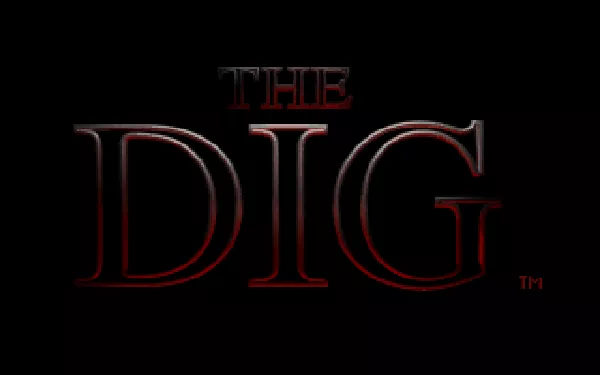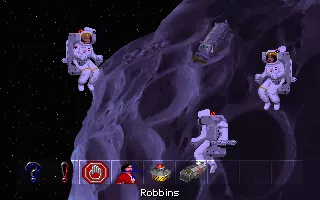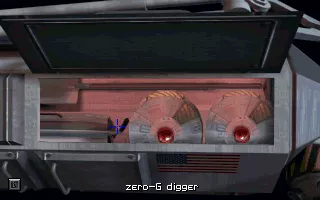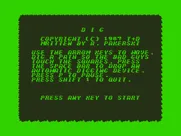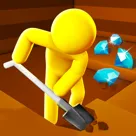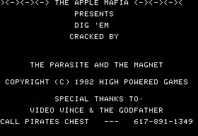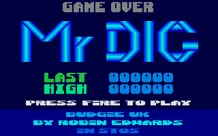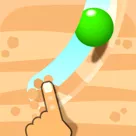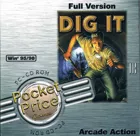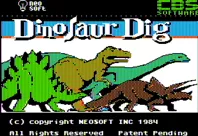The Dig
Description official descriptions
A group of scientists discovers an asteroid that is on its way to a collision with the Earth. Is there any way to prevent the disaster? Boston Low, a NASA veteran, is sent to command a space expedition on the asteroid. Accompanied by the journalist Maggie Robbins and the archaeologist Brink, Boston investigates the asteroid and finds a strange structure that undoubtedly belongs to an alien civilization. During the course of investigations, the team finds itself on a seemingly deserted planet. They have no knowledge of the planet and no possibility of going back. Will they ever discover the secret of this strange world and find a way to get home?
The Dig is a point-and-click adventure game with a simple one-cursor interface. Most of the puzzles are inventory-based, tending to be somewhat more complex than in most preceding LucasArts' adventure games. There are also a few logic-based puzzles, which require understanding and manipulation of alien technology and life forms on the planet. Traditional branching dialogue system is utilized; however, the game focuses more on puzzle-solving than on conversations to advance the plot.
The game's story is influenced by science fiction literature and movies, and strives to be realistic, departing from the comedy style of LucasArts' adventures. Despite that, humorous elements are present in some of the dialogues and text descriptions. The game utilizes hand-drawn graphics with a few pre-rendered 3D images.
Spellings
- 异星搜奇 - Simplified Chinese spelling
- 디그 - Korean spelling
Groups +
Screenshots
Promos
Credits (DOS version)
235 People (207 developers, 28 thanks) · View all
| Designed by | |
| Directed by | |
| Based on a Concept by | |
| Dialogue by | |
| Additional Story by | |
| Additional Additional Story by | |
| Art Style | |
| Creature Concept | |
| Lead Artist | |
| Background Art | |
| Supervising Animators | |
| Animators | |
| Special Effects Animators | |
| Additional Animation | |
| [ full credits ] | |
Reviews
Critics
Average score: 82% (based on 38 ratings)
Players
Average score: 3.9 out of 5 (based on 236 ratings with 21 reviews)
Under-rated game that never did as well as it should have.
The Good
There's so much to like about this game, I never understand why no one liked it. So being the only soul in the free world who enjoyed it, I feel I need to speak out on it's behalf.
The best aspect of the game I found was the graphics. All the backgrounds are luscious hand-painted pieces that truly show off the alien plane'ts evocative landscapes. A close second behind that is Michael Land's classic Wagnerian score. Very few games before or after "The Dig" have managed to have such a well put together score, and it's a joy to listen to it every time you play.
Spielberg's story can't be beat, and the voice-actors really bring the characters in the story to life. Yes, the game was a bit wordy, but I like this in a game. Overall, I thought this was a great game that never found the audience it deserved.
The Bad
I din't like the fact that it sold so poorly that there's no chance of a sequel to continue the story! Seriously though, I never encountered any bugs in the game, but that's mostly on par with Lucasarts' track record.
The Bottom Line
Go out and look for it in the bargain bins. A game this good shouldn't be forgotten.
DOS · by Digital Arse (9) · 2000
The Good
This game has some interesting and not so interesting but nice qualities. I liked the cool cinematic sequences and the sort of Spielberesque movie music. The story manages to be intriguing and the atmosphere also works for me. The puzzles are a little atypical but I'd say they were difficult enough and kind of refreshing. The tone of the game is between dramatic and facetious, something that I thought was well handled (I did laugh, I did smile, and I was surprised at the level of cynicism in the game). The voice acting is competent.
The Bad
I think it lacks something. It lacks more adventure gaming. The inventory possibilities were not so abundant and some puzzles didn't make any damn sense and were silly too.
I also noticed plot holes in the story (like how the first ghost managed to give the team the crystal rod if the ghosts supposedly can't cause anything in Spacetime 4 but little energy disturbances?). The game ends too abruptly and the happy ending was cheap.
The inflated music turns monotonous eventually.
The Bottom Line
An atypical and sort of interesting Lucasarts adventure game.
DOS · by Czar Husk Qi (27) · 2007
Different; and neither a masterpiece nor a bad game.
The Good
Jeez...this one is controversial isn't it? Take a look at the reviews all over the net: opinion is pretty heavily divided. It wouldn't be though, if it was made by a developing company other than Lucasarts. The public, having lapped up the 'Monkey Islands' and 'Sam & Max' like starving puppies, expected more of the same with this title. And why shouldn't they? This is what happens when you get typecasted. Sad, really.
'The Dig' is nothing like 'Sam & Max'; the aforementioned, highly revered, adventure Sean Clark also worked on, and it's to his credit that he's created something so different. The game starts brilliantly: the intro movie is good and the player's first challenge is an exciting one. It shows that this was originally intended to be a film - (it's a common rule in screen writing that the first 10 minutes of the script have to hook the audience. Often they are constructed as a small 10 minute vignette, as is the case here.) Events progress logically up until you've been on the alien planet for a bit, then it starts to go downhill. Typically, the plot starts to disappear until nearer the end. But hey - at least now you're gripped. Sort of.
Character development is very good, and I'm a sucker for this type of thing, so I was most impressed. Especially since Sam & Max doesn't have any. All 3 characters grow and change by the end, furthering the feel that you're playing an epic. The score is also suitably "Wagnerian", as it claims to be, and the dialogue is good, if occasionally overblown.
Graphically, 'The Dig' is very polished. Although it does suffer from being in the period of graphical development where environments and vehicles can be animated in 3D polygonal glory, but not humans or creatures. This occasionally makes the characters look rough and flat against the backgrounds. Although, yeah, wow Ed, big deal.
The 'serious' plot, which is only really developed at the end, is actually quite interesting too.
The Bad
Adventure gamers come under a lot of stick for being notoriously stifling to the creativity of developers. That's one way of putting it. Another is that they know exactly what they want and yet the developers don't seem to share their vision. I wouldn't call myself a hardcore gamer at all, but I've often discussed the adventure sequels that Lucasarts have teased us with: Full Throttle 2, Sam & Max 2, and the next Monkey Island. We always agree on what we feel are highly important aspects; it is vital, for instance, that a sequel to Full Throttle would attempt to keep that same darkness, that same ugly brutality, that made the original so vivid. It seems obvious. Screenshots of the sequel before it was canned suggest this wasn't even taken into account.
It is also obvious that 'Myst'-style puzzles in 'The Dig' would be unwanted. The legions of people who bought Myst liked the pretty pictures the most, not the puzzles, which hark back to games like 'The Fool's Errand'. Whilst I think back fondly to the time when Lucasarts were willing to go out on a whim and try something different, it doesn't mean all their decisions have to have been good ones. Messing with polygons is alright for a bit, but it soon gets boring.
Can't blame them too much for that though, and to be honest, there isn't too much of that in the game. They deserve to hang for that infamous turtle skeleton puzzle however. I stared at a screenshot of the solution for nearly a whole hour, convinced my version had a bug which wasn't letting my complete it, before changing one imperceptible thing and then it finally worked. C'mon guys, you didn't give us this type of thing in 'Loom' and that was 6 years ago, why give us it now?
Going back to what I said about the game going downhill, the problem is that after you've been on the planet for a while, you'll end up at a central 'hub' and the other characters will suddenly go off and leave you on your own. All of a sudden, you don't have a clue what you're doing. There are some doors which are shut, maybe you can open them, somehow. There is a machine with some buttons, you can press them but they don't seem to do anything. Warren Spector, creator of one of the finest games ever, 'Deus Ex', once said in an interview how desperate he was to take players into worlds they can recognise. Players' creative imaginations are stirred in a game when they see a telephone ("Can I make a phone call"?) but not when they see an alien artifact. Whilst this game deserves no blame for being set on an alien planet, abandoning the player in such a fashion is a very foolish move when this is taken into account. Having few NPCs to interact with doesn't help either.
The situations in 'The Dig' are not humorous, and neither are the characters particularly. Not that this is a bad thing at all, but Lucasarts in the past have rightly concluded that humour equals staying power in adventures. Getting past that %#$*@! puzzle deserves a reward, and a funny sequence does the job perfectly. Ron Gilbert positioned 'rewards' like these perfectly in the first 2 Monkey Islands, and they were often genuinly funny to boot. 'The Dig' doesn't have many of these - your hard work usually just opens up a new area, which is usually empty. This isolation and the lack of cutscenes begins to frustrate after a while. It gets better near the end though.
A personal gripe is that the whole game is spent in one place. I hate it when I find central hubs in adventures - you walk into a place with loads of doors and you just know you're going to spend the rest of the game walking through them. 'Grim Fandango' and 'Full Throttle' were two of the best when it came to this: the latter had you riding all over the country, so you were never in one place for too long. And in Grim, you were journeying all over the world. You never knew where you were going to be next, but you knew it would be completely different and exciting. The first time I saw the transition from the end of Year 1, where you were in a port-side ghost town, to Year 2, where the town had been transformed into something resembling Monte Carlo or Vegas, was the best moment I've ever had with an adventure game. You won't get that in 'The Dig', you're stuck with these rocks and artifacts and you know you ain't leaving any time soon.
I like the ending, but it's implausable.
The Bottom Line
Not a typical Lucasarts adventure, but still highly polished and well worth playing. It resembles 'Myst' not just in the puzzles but also in the sense of isolation, but it's an infinitly better game. You should still buy it; all Lucasarts' adventures are worth buying (so far, and since 'Loom' at least).
You won't "feel at home" with the adventure, but why should you? You're on an alien planet.
DOS · by Shazbut (163) · 2004
Discussion
| Subject | By | Date |
|---|---|---|
| Messy credits | chirinea (47496) | Jun 16, 2007 |
| How did you like the voice acting in this game? | LepricahnsGold (142748) | Jun 8, 2007 |
Trivia
1001 Video Games
The Dig appears in the book 1001 Video Games You Must Play Before You Die by General Editor Tony Mott.
Alien and planet name
The planet and aliens are not given a name, however the credits refer to the "Cocytan leader".
In the novelization, Brink decides to name the planet "Cocytus" from Dante's Divine Comedy, Cocytus being the exterior circle of the Underworld and the only way out. The aliens thus are referred to as "Cocytans". However, these concepts are not taken into consideration in the game.
Development
The Dig is based on the original concept of Steven Spielberg who originally created the storyline to be an episode in his Amazing Stories tv series. It would have been too expensive to shoot, so Spielberg approached LucasArts in 1989 with an idea of making it a game. The game itself went through several re-writes at LucasArts, so only the main storyline and a couple of puzzles were carried out from Spielberg's original ideas.
The Dig went through three phases of development while in production, each with different project leaders.
The first phase was led by Noah Falstein. In this version, the game was set upon a jungle planet, very unlike the final version. One major part of this version apparently was that you had to collect and consume food and water to keep your character alive.
The second phase was led by Brian Moriarty. Moriarty tossed out all of the old art from the first version, as well as the "collecting resources" RPG-style elements.
In this version, there were four characters: Boston Low, Ludger Brink, Judith Robbins, and Toshi Olema, a Japanese physicist. As in the final game, this crew was transported to an alien planet via a ship disguised as an asteroid.
This version was controlled via a standard LucasArts-style interface at the bottom of the screen containing visual icons for the functions Examine, Pick up, Use, Move, and Talk, as well as inventory items. Strangely, the game was not programmed in LucasArts' standard SCUMM engine, but instead something called StoryDroid Development System.
After a long series of internal conflicts, Brian Moriarty left the company and Sean Clark took over the project. Clark was the one who actually got the game finished. He changed Judith's name to Maggie and removed Toshi Olema from the plot.
In early betas of Sean Clark's version, the characters looked the same as they did in Brian Moriarty's version (with Low and Robbins both having blond hair). These sprites were later changed and made more visually striking.
In addition, though early betas of this new version used an interface at the bottom of the screen with the same icons for interaction as in Moriarty's game, this was later rejected for the final "one-click-does-it-all" interface which the public saw.
Also, the voices in the final game were not the same as those heard in early betas of Clark's The Dig. Those unused voices lasted long enough to be present in the official demo of The Dig.
Extras
Some copies of The Dig came with a free copy of the Trade Paperback version of Alan Dean Foster's game novelization (a $12.95 value according to the box sticker).
Novel
Although there's no movie based on it, there is a book based on the game, also called The Dig, written by science fiction writer Alan Dean Foster.
References
- Main character Boston Low is voiced by Robert Patrick, who incarnated the evil liquid terminator in the movie Terminator 2. At one point in the game, Boston shows Maggie a photo of lost comrade Brink, and asks her "Have you seen this boy?", paraphrasing the evil terminator's trademark question in that popular movie. Also, when the player looks at his PenUltimate he's gonna say that it's the "T-1000 Model".
- According to the game's demo, the ship that carries out the Attila mission in the first part of the game is Space Shuttle Atlantis. However this reference was cut from the final game.
Shapes
Take a look at the PenUltimate communicator and you will notice that there is a geometric shape on it. It is what the plates inside Atilla look like when they are put together.
Soundtrack
Even though Michael Land's score for the game was released on CD (albeit in a very low amount), it suffered from the worst 'disease' of all official soundtracks, painfully well known to collectors of film scores - it was cut, and not all the music appearing in the game was included. However, the tracks can be extracted with external utilities. Details can be found in the tips & tricks section.
Title
After finishing the game, you might start to wonder if the game's title is in any way connected to the over-usage of the shovel item in the game (main character digs holes every now and then, and rather often), because there is definitely no dig site to explore (not assuming half-blasted asteroid).
Awards
- Computer Gaming World
- November 1996 (15th anniversary issue) – #3 Top Vaporware Title in Computer Game History
Information also contributed by ATMachine, Boston Low, ClydeFrog, Daniel Albu, Dirk Struan, G J, Jaromir Krol, MAT, Swordmaster and Trixter
Analytics
Upgrade to MobyPro to view research rankings!
Related Sites +
-
GJ's Dig Site
Character profiles, images including ads, screenshots, backgrounds, etc, humour. -
Hints for The Dig
These won't spoil the game, but will give you just what you need to solve the game. Final solutions are included. -
ScummVM
Get "The Dig", as well as many other adventure games, to run on modern systems by using ScummVM, a legal and free program. -
The Dig - FAQs & Guides
Several walkthroughs and other files on GameFaqs.com -
The Dig Museum
Includes interviews with creators, creation information, and "Ask Yoda" section. -
The Dig Soundtrack
Music from the game -
The Dig Walkthrough
Start to finish solution for The Dig
Identifiers +
Contribute
Are you familiar with this game? Help document and preserve this entry in video game history! If your contribution is approved, you will earn points and be credited as a contributor.
Contributors to this Entry
Game added by robotriot.
Linux added by click here to win an iPhone9SSSS. Antstream added by lights out party. Windows added by MAT. Macintosh added by Jason Savage.
Additional contributors: Mickey Gabel, Unicorn Lynx, Jeanne, Apogee IV, G J, CubbyKatz, CaesarZX, Picard, Patrick Bregger, FatherJack.
Game added November 1, 1999. Last modified April 12, 2024.





